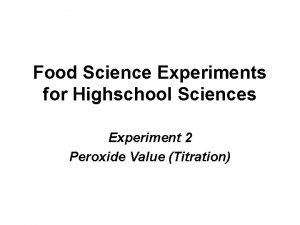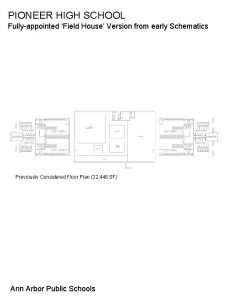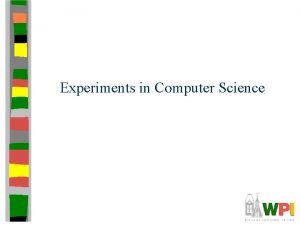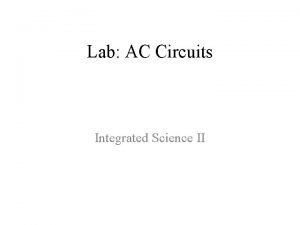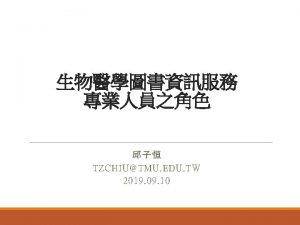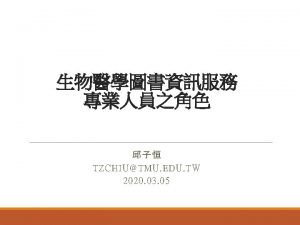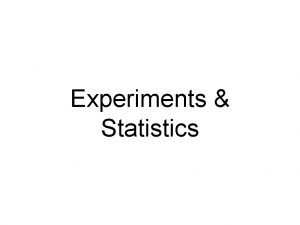Food Science Experiments for Highschool Sciences Experiment 2










- Slides: 10

Food Science Experiments for Highschool Sciences Experiment 2 Peroxide Value (Titration)

Fatty acids • Fatty acids are: – straight chains of carbon atoms with hydrogen atoms attached (hydrocarbons) – with a carboxylic group (COOH) attached at one end and – a methyl group (CH 3) at the other end. • Fatty acids can be: – saturated (carbon chain with only single bonds) or – unsaturated (carbon chain has one or more double bonds).

Saturated fatty acids • Saturated fatty acids are straight chain molecules that can easily line up and associate with each other to form a crystalline structure, resulting in a solid fat at room temperature. • The appearance (rough, smooth, shiny), hardness, and light reflection characteristics (colour) of solid fats are influenced by how the various fatty acid chains associate.

Unsaturated Fatty Acids • Double bonds in food fats and oils are usually present in the cis conformation. • A. H atoms attached to the carbon atoms in the double bond are on the same side. • The trans conformation is rare • B. Hydrogen atoms attached to the carbons atoms in the double bond are on opposite sides

Cis double bonds • Cis double bonds result in “kinks” in the carbon chain and therefore disrupt physical interactions with other fatty acid molecules, preventing them from packing together in a crystalline structure. • This results in a liquid structure or oil.

Lipid oxidation • Lipid oxidation results in the production of off-flavours and odours, which is referred to as oxidative rancidity. • Other effects of lipid oxidation include a decrease in nutritive value, colour changes, and sometimes the production of toxic compounds. • Lipid oxidation therefore has a detrimental effect on food quality as the more oxidised the food lipids, the less desirable the food is to eat. • This also applies to fats and oils used for frying. If the fat or oil is rancid, the rancid flavours and odours will be transferred to the food as the fat or oil is absorbed into it during frying.

Lipid Oxidation • Two common mechanisms in food: – Autoxidation via a free-radical chain reaction mechanism. – Enzyme catalysed oxidation which is a result of specific enzymes present in foods acting on polyunsaturated fatty acids. – Both mechanisms result in the formation of hydroperoxide intermediates (ROOH), which readily react further to form the hydroxyl acids, keto acids, aldehydes, and short chain fatty acids responsible for rancid off-flavours and odours.

Measurement of lipid oxidation • The degree of oxidation of a fat or oil sample can be measured by determining the peroxide value. • Peroxides are the main initial products of autoxidation and can be measured using a technique that is based on their ability to liberate iodine from potassium iodide. • The peroxide value is determined by measuring the iodine released from potassium iodide using sodium thiosulphate titration. This process is represented by the following chemical equations: 1. ROOH + 2 KI I 2 + 2 KOH + ROhydroperoxide + potassium iodide iodine + potassium hydroxide + oxidised peroxide 2. I 2 + Na 2 S 2 O 3 + 2 Na. I iodine + sodium thiosulphate sulphur trioxide + sodium iodide

Antioxidants • Antioxidants are compounds used to control or retard oxidative reactions via two main mechanisms: 1. By interrupting the free radical chain mechanism 2. By being preferentially oxidised, for example the antioxidant (AH) reacts with radicals to form non-radical molecules: R + AH RH + A A + R RA

Figure 1: Peroxide values of oils after heating at 140˚C
 Science experiments for highschool
Science experiments for highschool Keystone national highschool
Keystone national highschool Osbourn park high school ranking
Osbourn park high school ranking Ice cube highschool
Ice cube highschool Ponchatoula highschool football
Ponchatoula highschool football Vita highschool vita
Vita highschool vita Pioneer high school map
Pioneer high school map Human sciences tok definition
Human sciences tok definition Computer science experiments
Computer science experiments Integrated science lab experiments
Integrated science lab experiments Science experiment risk assessment
Science experiment risk assessment
